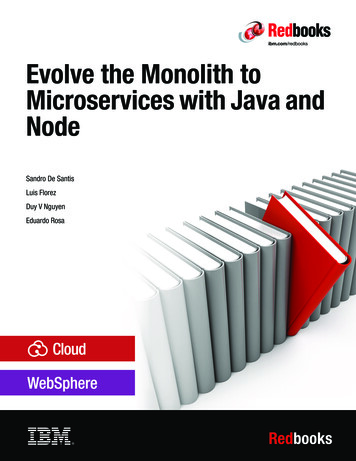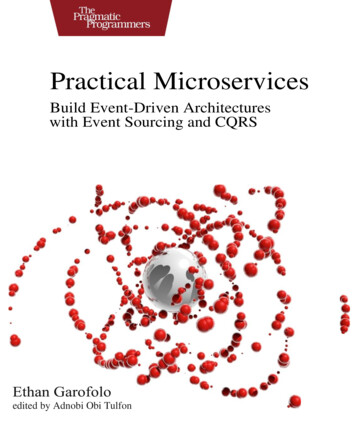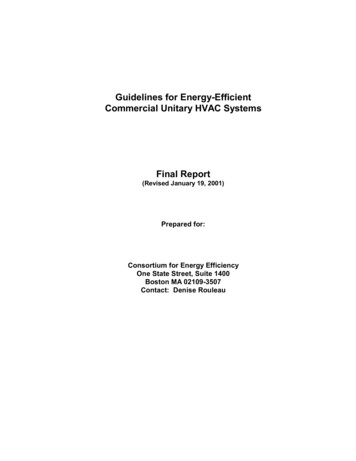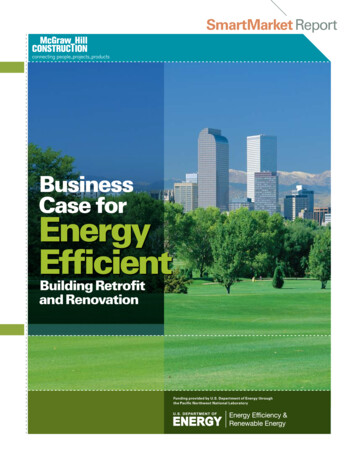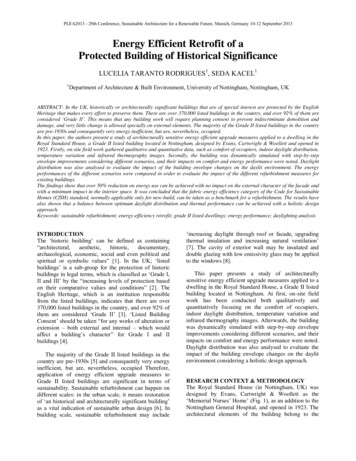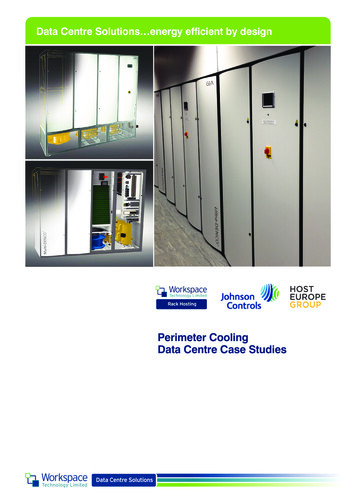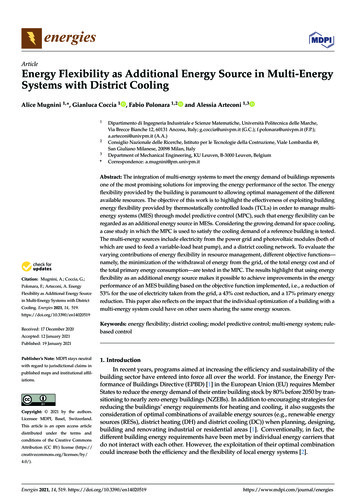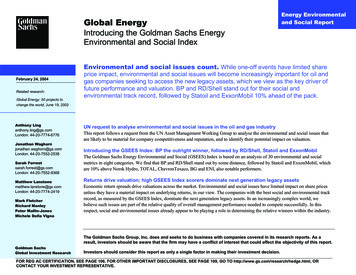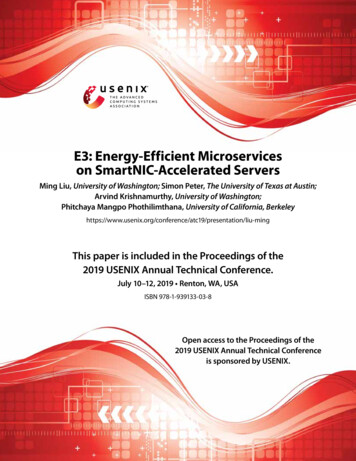
Transcription
E3: Energy-Efficient Microserviceson SmartNIC-Accelerated ServersMing Liu, University of Washington; Simon Peter, The University of Texas at Austin;Arvind Krishnamurthy, University of Washington;Phitchaya Mangpo Phothilimthana, University of California, esentation/liu-mingThis paper is included in the Proceedings of the2019 USENIX Annual Technical Conference.July 10–12, 2019 Renton, WA, USAISBN 978-1-939133-03-8Open access to the Proceedings of the2019 USENIX Annual Technical Conferenceis sponsored by USENIX.
E3: Energy-Efficient Microservices on SmartNIC-Accelerated ServersMing LiuUniversity of WashingtonSimon PeterThe University of Texas at AustinArvind KrishnamurthyUniversity of WashingtonPhitchaya Mangpo Phothilimthana University of California, BerkeleyAbstractWe investigate the use of SmartNIC-accelerated servers toexecute microservice-based applications in the data center.By offloading suitable microservices to the SmartNIC’s lowpower processor, we can improve server energy-efficiencywithout latency loss. However, as a heterogeneous computingsubstrate in the data path of the host, SmartNICs bring severalchallenges to a microservice platform: network traffic routingand load balancing, microservice placement on heterogeneoushardware, and contention on shared SmartNIC resources.We present E3, a microservice execution platform forSmartNIC-accelerated servers. E3 follows the design philosophies of the Azure Service Fabric microservice platform andextends key system components to a SmartNIC to addressthe above-mentioned challenges. E3 employs three key techniques: ECMP-based load balancing via SmartNICs to thehost, network topology-aware microservice placement, anda data-plane orchestrator that can detect SmartNIC overload.Our E3 prototype using Cavium LiquidIO SmartNICs showsthat SmartNIC offload can improve cluster energy-efficiencyup to 3 and cost efficiency up to 1.9 at up to 4% latencycost for common microservices, including real-time analytics,an IoT hub, and virtual network functions.1IntroductionEnergy-efficiency has become a major factor in data center design [80]. U.S. data centers consume an estimated 70billion kilowatt-hours of energy per year (about 2% of total U.S. energy consumption) and as much as 57% of thisenergy is used by servers [22, 74]. Improving server energyefficiency is thus imperative [17]. A recent option is the integration of low-power processors in server network interfacecards (NICs). Examples are the Netronome Agilio-CX [59],Mellanox BlueField [51], Broadcom Stingray [13], and Cavium LiquidIO [15], which rely on ARM/MIPS-based processors and on-board memory. These SmartNICs can process Theauthor is now at Google.USENIX Associationmicrosecond-scale client requests but consume much less energy than server CPUs. By sharing idle power and the chassiswith host servers, SmartNICs also promise to be more energyand cost efficient than other heterogeneous or low-power clusters. However, SmartNICs are not powerful enough to runlarge, monolithic cloud applications, preventing their offload.Today, cloud applications are increasingly built as microservices, prompting us to revisit SmartNIC offload in thecloud. A microservice-based workload comprises loosely coupled processes, whose interaction is described via a dataflowgraph. Microservices often have a small enough memory footprint for SmartNIC offload and their programming modelefficiently supports transparent execution on heterogeneousplatforms. Microservices are deployed via a microserviceplatform [3–5, 40] on shared datacenter infrastructure. Theseplatforms abstract and allocate physical datacenter computingnodes, provide a reliable and available execution environment,and interact with deployed microservices through a set ofcommon runtime APIs. Large-scale web services already usemicroservices on hundreds of thousands of servers [40, 41].In this paper, we investigate efficient microservice execution on SmartNIC-accelerated servers. Specifically, we areexploring how to integrate multiple SmartNICs per serverinto a microservice platform with the goal of achieving betterenergy efficiency at minimum latency cost. However, transparently integrating SmartNICs into microservice platforms isnon-trivial. Unlike traditional heterogeneous clusters, SmartNICs are collocated with their host servers, raising a numberof issues. First, SmartNICs and hosts share the same MACaddress. We require an efficient mechanism to route andload-balance traffic to hosts and SmartNICs. Second, SmartNICs sit in the host’s data path and microservices runningon a SmartNIC can interfere with microservices on the host.Microservices need to be appropriately placed to balancenetwork-to-compute bandwidth. Finally, microservices cancontend on shared SmartNIC resources, causing overload. Weneed to efficiently detect and prevent such situations.We present E3, a microservice execution platform forSmartNIC-accelerated servers that addresses these issues. E32019 USENIX Annual Technical Conference363
Microservices simplify distributed application developmentand are a good match for low-power SmartNIC offload. Together, they are a promising avenue for improving serverenergy efficiency. We discuss this rationale, quantify the potential benefits, and outline the challenges of microserviceoffload to SmartNICs in this section.2.1MicroservicesMicroservices have become a critical component of today’sdata center infrastructure with a considerable and diverseworkload footprint. Microsoft reports running microservices24/7 on over 160K machines across the globe, includingAzure SQL DB, Skype, Cortana, and IoT suite [40]. Googlereports that Google Search, Ads, Gmail, video processing,flight search, and more, are deployed as microservices [41].These microservices include large and small data and codefootprints, long and short running times, billed by run-time3642019 USENIX Annual Technical ConferenceSQL storeData analyticsSpikeEMARecommendAPI GatewaySQL store BackgroundAPI GatewaySensor logging 2Authentication follows the design philosophies of the Azure Service Fabricmicroservice platform [40] and extends key system components to allow transparent offload of microservices to a SmartNIC. To balance network request traffic among SmartNICsand the host, E3 employs equal-cost multipath (ECMP) loadbalancing at the top-of-rack (ToR) switch and provides highperformance PCIe communication mechanisms between hostand SmartNICs. To balance computation demands, we introduce HCM, a hierarchical, communication-aware microservice placement algorithm, combined with a data-plane orchestrator that can detect and eliminate SmartNIC overload viamicroservice migration. This allows E3 to optimize server energy efficiency with minimal impact on client request latency.We make the following contributions: We show why SmartNICs can improve energy efficiencyover other forms of heterogeneous computation and howthey should be integrated with data center servers and microservice platforms to provide efficient and transparentmicroservice execution (§2). We present the design of E3 (§3), a microservice runtimeon SmartNIC-accelerated server systems. We present itsimplementation within a cluster of Xeon-based servers withup to 4 Cavium LiquidIO-based SmartNICs per server (§4). We evaluate energy and cost-efficiency, as well as clientobserved request latency and throughput for common microservices, such as a real-time analytics framework, anIoT hub, and various virtual network functions, across various homogeneous and heterogeneous cluster configurations (§5). Our results show that offload of microservicesto multiple SmartNICs per server with E3 improves clusterenergy-efficiency up to 3 and cost efficiency up to 1.9 at up to 4% client-observed latency cost versus all othercluster configurations.SpikeEMARecommendMicroservice platform (Service Fabric, E3, )ServerServerFigure 1: Thermostat analytics as DAG of microservices. Theplatform maps each DAG node to a physical computing node.and by remote procedure call (RPC) [28]. What unifies theseservices is their software engineering philosophy.Microservices use a modular design pattern, which simplifies distributed application design and deployment. Microservices are loosely-coupled, communicating through a set ofcommon APIs, invoked via RPCs [86], and maintain statevia reliable collections [40]. As a result, developers can takeadvantage of languages and libraries of their choice, whilenot having to worry about microservice placement, communication mechanisms, fault tolerance, or availability.Microservices are also attractive to datacenter operators asthey provide a way to improve server utilization. Microservices execute as light-weight processes that are easier to scaleand migrate compared with a monolithic development approach. They can be activated upon incoming client requests,execute to request completion, and then swapped out.A microservice platform, such as Azure Service Fabric[40], Amazon Lambda [3], Google Application Engine [4], orNirmata [5], is a distributed system manager that enables isolated microservice execution on shared datacenter infrastructure. To do so, microservice platforms include the followingcomponents (cf. [40]): 1. federation subsystem, abstractingand grouping servers into a unified cluster that holds deployedapplications; 2. resource manager, allocating computation resources to individual microservices based on their executionrequirements; 3. orchestrator, dynamically scheduling and migrating microservices within the cluster based on node healthinformation, microservice execution statistics, and servicelevel agreements (SLAs); 4. transport subsystem, providing(secure) point-to-point communication among various microservices; 5. failover manager, guaranteeing high availability/reliability through replication; 6. troubleshooting utilities,which assist developers with performance profiling/debuggingand understanding microservice co-execution interference.A microservice platform usually provides a number ofprogramming models [10] that developers adhere to, likedataflow and actor-based. The models capture the executionrequirements and describe the communication relationshipamong microservices. For example, the data-flow model (e.g.Amazon Datapipe [6], Google Cloudflow [29], Azure DataUSENIX Association
Factory [55]) requires programmers to assemble microservices into a directed acyclic graph (DAG): nodes contain microservices that are interconnected via flow-controlled, lossless dataflow channels. These models bring attractive benefitsfor a heterogeneous platform since they explicitly express concurrency and communication, enabling the platform to transparently map it to the available hardware [68, 70]. Figure 1shows an IoT thermostat analytics application [54] consistingof microservices arranged in 3 stages: 1. Thermostat sensorupdates are authenticated by the API gateway; 2. Updates arelogged into a SQL store sharded by a thermostat identifier;3. SQL store updates trigger data analytic tasks (e.g, spikedetection, moving average, and recommendation) based onthresholds. The dataflow programming model allows the SQLstore sharding factor to be dynamically adjusted to scale theapplication with the number of thermostats reporting. Reliable collections ensure state consistency when re-shardingand the microservice platform automatically migrates anddeploys DAG nodes to available hardware resources.A microservice can be stateful or stateless. Stateless microservices have no persistent storage and only keep statewithin request context. They are easy to scale, migrate, andreplicate, and they usually rely on other microservices forstateful tasks (e.g., a database engine). Stateful microservicesuse platform APIs to access durable state, allowing the platform full control over data placement. For example, ServiceFabric provides reliable collections [40], a collection of datastructures that automatically persist mutations. Durable storage is typically disaggregated for microservices and accessedover the network. The use of platform APIs to maintain stateallows for fast service migration compared with traditionalvirtual machine migration [19], as the stateful working setis directly observed by the platform. All microservices inFigure 1 are stateful. We describe further microservices in §4.amples include match-and-action processing [25, 43] for network dataplanes, NPUs [26], and TPUs [39] for deep neuralnetwork inference acceleration. FPGAs and ASICs do notsupport transparent microservice offload. However, they canbe combined with general-purpose SmartNICs.A SmartNIC-accelerated server is a commodity server withone or more SmartNICs. Host and SmartNIC processors donot share thermal, memory, or cache coherence domains, andcommunicate via DMA engines over PCIe. This allows themto operate as independent, heterogeneous computers, whilesharing a power domain and its idle power.SmartNICs hold promise for improving server energyefficiency when compared to other heterogeneous computingapproaches. For example, racks populated with low-powerservers [8] or a heterogeneous mix of servers, suffer fromhigh idle energy draw, as each server requires energy topower its chassis, including fans and devices, and its own ToRswitch port. System-on-chip designs with asymmetric performance, such as ARM’s big.LITTLE [38] and DynamIQ [2]architectures, and AMD’s heterogeneous system architecture(HSA) [7], which combines a GPU with a CPU on the samedie, have scalability limits due to the shared thermal designpoint (TDP). These architectures presently scale to a maximum of 8 cores, making them more applicable to mobilethan to server applications. GPGPUs and single instructionmultiple threads (SIMT) architectures, such as Intel’s XeonPhi [36] and HP Moonshot [34], are optimized for computational throughput and the extra interconnect hop preventsthese accelerators from running latency-sensitive microservices efficiently [57]. SmartNICs are not encumbered by theseproblems and can thus be used to balance the power draw oflatency-sensitive services efficiently.2.2We quantify the potential benefit of using SmartNICs for microservices on energy efficiency and request latency. To doso, we choose two identical commodity servers and equip onewith a traditional 10GbE Intel X710 NIC and the other with a10GbE Cavium LiquidIO SmartNIC. Then we evaluate 16 different microservices (detailed in §4) on these two servers withsynthetic benchmarks of random 512B requests. We measurerequest throughput, wall power consumed at peak throughput(defined as the knee of the latency-throughput graph, wherequeueing delay is minimal) and when idle, as well as clientobserved, average/tail request latency in a closed loop. We usehost cores on the traditional server and SmartNIC cores on theSmartNIC server for microservice execution. We use as manyidentical microservice instances, CPUs, and client machinesas necessary to attain peak throughput and put unused CPUsto their deepest sleep state. The SmartNIC does not supportper-core low power states and always keeps all 12 cores active,diminishing SmartNIC energy efficiency results somewhat.The SmartNIC microservice runtime system uses a kernel-SmartNICsSmartNICs have appeared on the market [15, 51, 59] andin the datacenter [25]. SmartNICs include computing units,memory, traffic managers, DMA engines, TX/RX ports, andseveral hardware accelerators for packet processing, such ascryptography and pattern matching engines. Unlike traditionalaccelerators, SmartNICs integrate the accelerator with theNIC. This allows them to process network requests in-line, atmuch lower latency than other types of accelerators.Two kinds of SmartNIC exist: (1) general-purpose, whichallows transparent microservice offload and is the architecturewe consider. For example, Mellanox BlueField [51] has 16ARMv8 A72 cores with 2 100GE ports and Cavium LiquidIO [15] has 12 cnMIPS cores with 2 10GE ports. TheseSmartNICs are able to run full operating systems, but alsoship with lightweight runtime systems that can provide kernelbypass access to the NIC’s IO engines. (2) FPGA and ASICbased SmartNICs target highly specialized applications. Ex-USENIX Association2.3Benefits of SmartNIC Offload2019 USENIX Annual Technical Conference365
Flow mon.DDoSKNNSpikeBayesAPI gwTop 9111.2118.3112.5113.9108.5119.7114.7Host .6109.2113.0Host (DPDK)CL99%121.75.212 30.7 155.612 0.050.1512 78.7 358.64 0.040.14 0.030.14 0.030.092 0.040.14 0.030.0912 0.050.212 45.8 161.312 25.783.012 80.6 .84.112.40.030.121.3 120.680.39.050.341.9 164.78.5 403.631.1 154.929.5 6K80.4K1.5K3.1K0.08K5.0K0.7K2.1K SmartNIC:Host (DPDK) RPJTable 1: Microservice comparison among host (Linux and DPDK) and SmartNIC. RPS Throughput (requests/s), W Active power(W), C Number of active cores, L Average latency (ms), 99% 99th percentile latency, RPJ Energy efficiency (requests/Joule).14Flow t Size [B]10241500Figure 2: Request size impact on SmartNIC RPJ benefits.bypass network stack (cf. §4). To break out kernel overheadsfrom the host experiments, we run all microservices on thehost in two configurations: 1. Linux kernel network stack; 2.kernel-bypass network stack [63], based on Intel’s DPDK [1].Table 1 presents measured peak request throughput, activepower (wall power at peak throughput minus idle wall power),number of active cores, (tail-)latency, and energy efficiency,averaged over 3 runs. Active power allows a direct comparisonof host to SmartNIC processor power draw. Energy efficiencyequals throughput divided by active power.Kernel overhead. We first analyze the overhead of inkernel networking on the host (Linux versus DPDK). Asexpected, the kernel-bypass networking stack performs better than the in-kernel one. On average, it improves energyefficiency by 21% (% column in Table 1) and reduces tail latency by 16%. Energy efficiency improves because (1) DPDKachieves similar throughput with fewer cores; (2) at peakserver CPU utilization, DPDK delivers higher throughput.SmartNIC performance. SmartNIC execution improvesthe energy efficiency of 12 of the measured microservicesby a geometric mean of 6.5 compared with host executionusing kernel bypass ( column in Table 1). The SmartNICconsumes at most 24.7W active power to execute these microservices while the host processor consumes up to 113W.IPSec, BM25, Recommend, and NIDS particularly benefit3662019 USENIX Annual Technical Conferencefrom various SmartNIC hardware accelerators (crypto coprocessor, fetch-and-add atomic units, floating point engines, andpattern matching units). NATv4, Count, EMA, KVS, Flowmonitor, and DDoS can take advantage of the computationalbandwidth and fast memory interconnect of the SmartNIC.In
and load balancing, microservice placement on heterogeneous hardware, and contention on shared SmartNIC resources. We present E3, a microservice execution platform for SmartNIC-accelerated servers. E3 follows the design philoso-phies of the Azure Service Fabric microservice platform a

